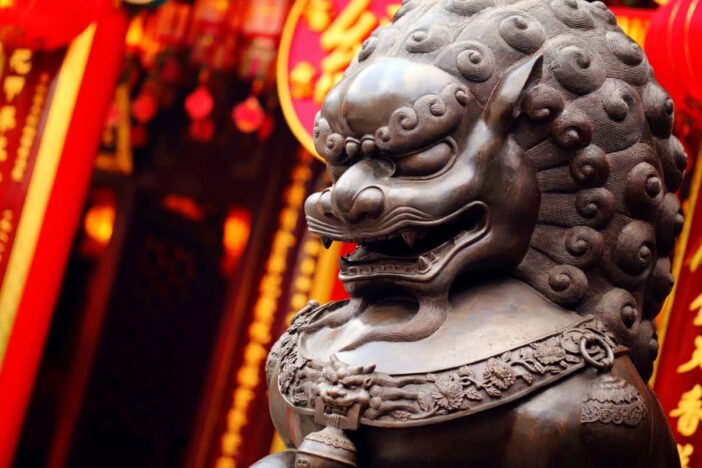
What are Foo Dogs?
Foo Dogs are Chinese protection symbols of feng shui that typically “guard” the entranceways to buildings and homes. Ironically, they don’t actually depict dogs, but rather lions. They are always presented in pairs and are traditionally carved from granite, marble or some other decorative stone. However, they may also be cast in iron, bronze or ceramic.
The materials and skills needed to make these statues are costly. So, they were usually made for the wealthiest families, royal palaces, tombs, and government buildings. Consequently, they represented not only sacred protectors against negative energy, but aristocratic status as well.

How did the Fu Dogs mythology develop?
Their mythology originated in Buddhism in the Chinese Han Dynasty during the second century B.C. In Buddhist stories, telling the truth of the Dharma is like “roaring like a lion.” This strong voice will eventually quiet all other sounds.
Asiatic lions, which were introduced to China through the Silk Road trade route, were often kept by the emperor. These live pets served as inspiration for the imperial guardian lion sculptures.
The Chinese refer to them as “shi” which literally translates to “lion.” Over the years, these symbolic lions became popular. They spread from China to Tibet, Thailand, Korea, Japan, and many other places in Asia.
Japan adopted them from Korea and referred to them as “Korean Dogs.” The Japanese then introduced them to Western cultures, who altered the name to “foo dogs” or “fu dogs.”
The words translate to “Buddha” and “prosperity.” However, the Chinese rarely use these prefixes in conjunction with guardian symbols and never refer to them as “dogs.” Inconsistent references are compounded by the fact that these statues often more closely resemble Chinese breeds of dogs (e.g. Chow Chow and Shih Tzu) than predatory lions.
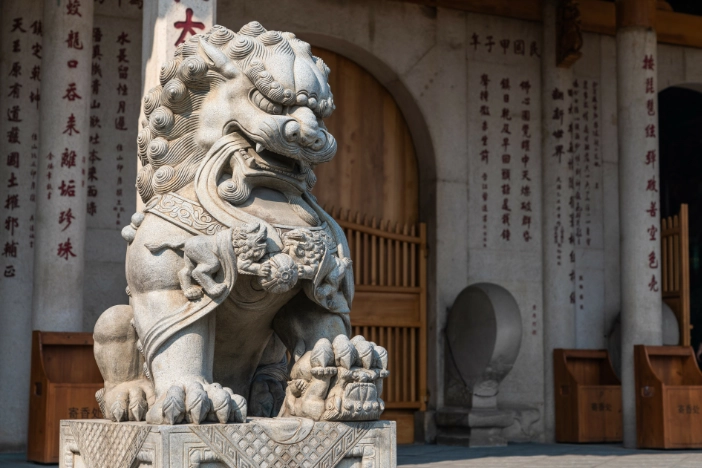
What do Chinese Lion statues look like?
Foo Dogs are usually depicted as fierce crouching beasts. Their menacing visages serve as deterrents to anyone who might wish to enter with malicious intent. The stylized eyes, teeth and claws of these Chinese totems reflect the power and raw emotion of the animal. In contrast, European depictions of lions are much more lifelike and with rippling muscles.
Each pair of guardian lions includes both female and male versions, which are manifestations of yin and yang. The male lion has an embroidered ball beneath his right front paw that represents the world. The female has a small cub under her left, which represents the cycle of life. He guards the outside physical structure, while she protects those living inside.
Their mouths may both be wide open, as if in mid-roar to scare off evil spirits, partially open with large pearls in them, or the female may have her mouth closed. When they are open and closed, it symbolizes the sacred sound “om.” This mantra is prevalent in Buddhism, Hinduism and other religions around the world.
Traditionally, when placed in front of high-ranking officials’ homes, the number of curls on a lion’s head denoted the rank of the official. The more curls, the higher the rank.
Over time, artistic depictions of guardian lions evolved. Early examples from the Han dynasty (25-220 AD) show slender elongated beasts with a rigid semi-realistic look. Centuries later, during the Qi dynasty (550-577 AD), they adopted a rounder natural appearance with well-defined muscles. The mane became much more stylized with circular spiral patterns on its surface and over the entire body as well.
Fu Dogs Quick Reference Etymology
| ORIGIN | NAME | MEANING | APPEARANCE |
|---|---|---|---|
| China | Shi Shishi Tongshi Ruishi | Lion Stone Lion Bronze Lion Auspicious Lion | Paw on ball or cub Made of stone Made of bronze White with turquoise mane |
| India | Sher/Singha | Lion | 4 facing cardinal directions |
| Japan | Shishi Komain | Lion Korean Dog | Open mouth Closed mouth |
| Korea | Haetae/Sanye | Lion | Scaly with horn & bell on neck |
| Thailand | Singha/Singh | Lion | May have wings & stand |
| Tibet | Gangs-Seng-Ge | Snow Lion | White with turquoise mane |

According to feng shui, how should Foo Dogs be arranged?
It’s important to properly arrange Chinese guardian lions to balance the good and bad chi energy of your home and maximize harmony and fortune. They should be placed on either side of a door or entryway looking outward. Facing the entrance, the male should be on the right and the female on the left.
Small statuettes, bookends or table lamps, should be kept in one room on the same table or shelf, and follow the placement recommendation. If they’re the same sex (sometimes it’s easier for manufacturers), be sure that the inside paws are the ones raised.
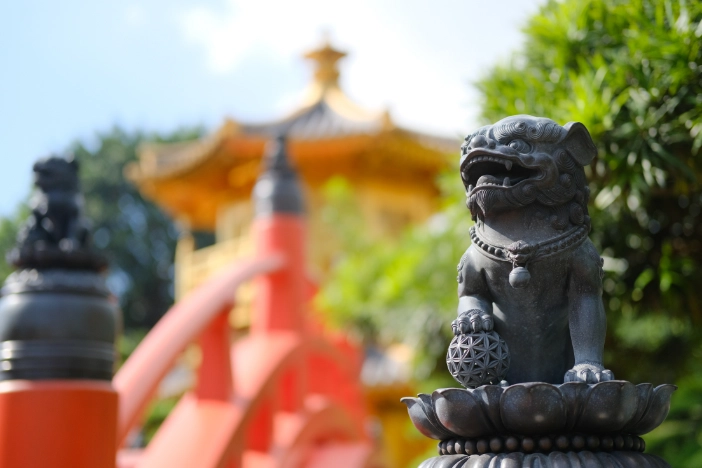
Where do you place a Foo Dog statue outdoors?
Stone lion statues are usually found by the front door, one on each side. However, they can be put in many other places outside a home.
Large marble versions work well at the entrance to your property alongside your driveway or sidewalk. The stairway up to your deck is another appropriate spot for these feng shui sentinels. If you have a traditional or zen garden, adding small stone or metal versions is a great way to show visitors the way in.
Tree-lined pathways that lead to secluded clearings or decorative gazebos are ideal spots for simple decoration. Chinese guardian lion statues set at the beginning of a trail at ground level or on pedestals entice people to enter.
Spacious homes or parks might have streams or koi ponds. They often have red pedestrian bridges called moon bridges or soribashi in Japanese. These structures symbolize the transition from the world of man to that of nature and paradise. Reinforce a bridge’s magical ambiance with ornately carved lion dogs at its approach.

What are Foo Lion placement rituals or ceremonies?
Chinese foo dog statues are usually placed with special ceremonies. These customs are based on traditional Chinese beliefs about protection, wealth, and harmony. Many modern installations might skip formal rituals. However, traditional methods based in feng shui, Taoism, and Chinese folklore can enhance the symbolic strength of the statues. Here’s a summary of usual rituals and ceremonial practices linked to placing fu shi:
Auspicious Timing (Ze Ri)
Installing foo dogs begins with selecting an auspicious date and time. It’s often conducted with guidance from a feng shui master or a Chinese almanac. This timing is aligned with the Chinese zodiac signs of household or business members to enhance good fortune and avoid spiritual conflicts.
Cleansing and Purification of Space and Statues
Both the physical location and the foo lion statues undergo a thorough cleansing. Spaces are swept and spiritually purified. Statues are wiped with herbal water (commonly mugwort or pomelo leaves) to dispel negative energy. Incense or sandalwood smoke may also be used to sanctify the area.
Activation Rituals (Kai Guang)
A kai guang ceremony “activates” the shishi’ spiritual power. This is performed by a Taoist, Buddhist, or feng shui practitioner. It includes:
- Chanting
- Offering incense and symbolic foods
- Anointing the statues’ eyes with red cinnabar or oil to “open” their vision
- Burning talismans to invite protective energies
Feng Shui-Based Placement and Pairing
Placement must follow traditional feng shui principles: fu dogs are always in pairs with the male on the right (with a ball) and female on the left (with a cub), facing outward to guard the entrance. Their location should avoid direct alignment with opposing doors, busy intersections, or dark, cluttered spaces.
Offerings and Ongoing Maintenance
Continued spiritual respect may include lighting incense, especially during festivals, and offering food items like fruit or tea. Annual cleansing rituals, specially before Lunar New Year, help maintain the foo lions’ protective energy and spiritual potency.
Integration with Other Deities and Symbols
Foo dogs often complement a larger spiritual arrangement. They work in tandem with door gods, wealth deities, or local earth gods (Tudi Gong). Their placement is coordinated to harmonize all protective and prosperity-enhancing elements within the environment.
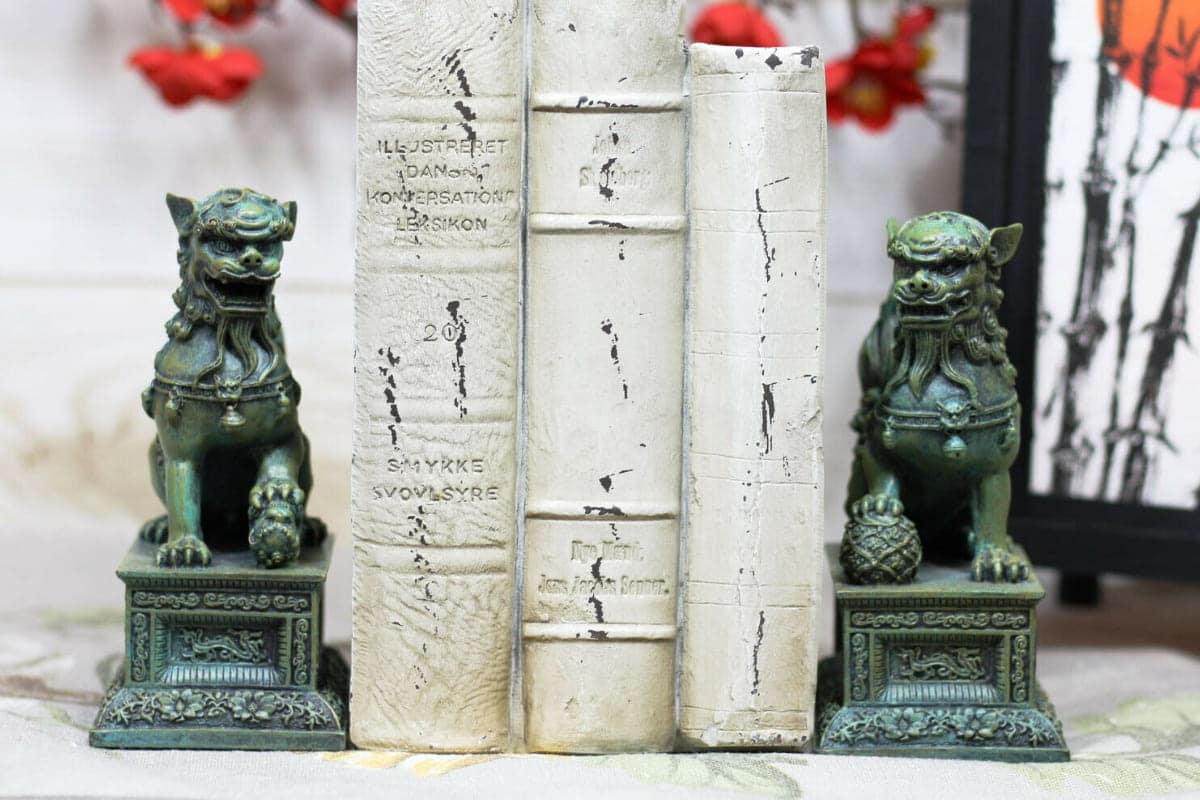
Does the color of your Lion Dogs (a.k.a. Shishi) matter?
Chinese metaphysical arts look at how things appear, their makeup, where they are, and the timing of events. These factors influence the unseen forces that connect everything…so, of course color matters. The placement of the Foo Dogs matters too. Their direction and where they are in relation to the entry door are important. And you thought quantum physics was complicated!
Feng Shui Wu Xing Cosmology
In feng shui, the direction in which a doorway faces is associated with different colors and elements. So, you can enhance the impact of your lions by following these Wu Xing guidelines.
- Center – Health & Well-Being
- North – Black – Career
- Northeast – Blue – Education & Knowledge
- East – Green – Family & New Beginnings
- Southeast – Purple – Wealth & Prosperity
- South – Red – Fame & Recognition
- Southwest – Brown, Yellow & Pink – Love & Relationships
- West – White, Gold & Silver (metal) – Creativity & Children
- Northwest – White, Gold & Silver (metal) – Mentors & Travel
Feng Shui Bagua Map
Small foo lions placed on tables, mantels, or other surfaces in a room should be in appropriate color spots according to the traditional bagua map.
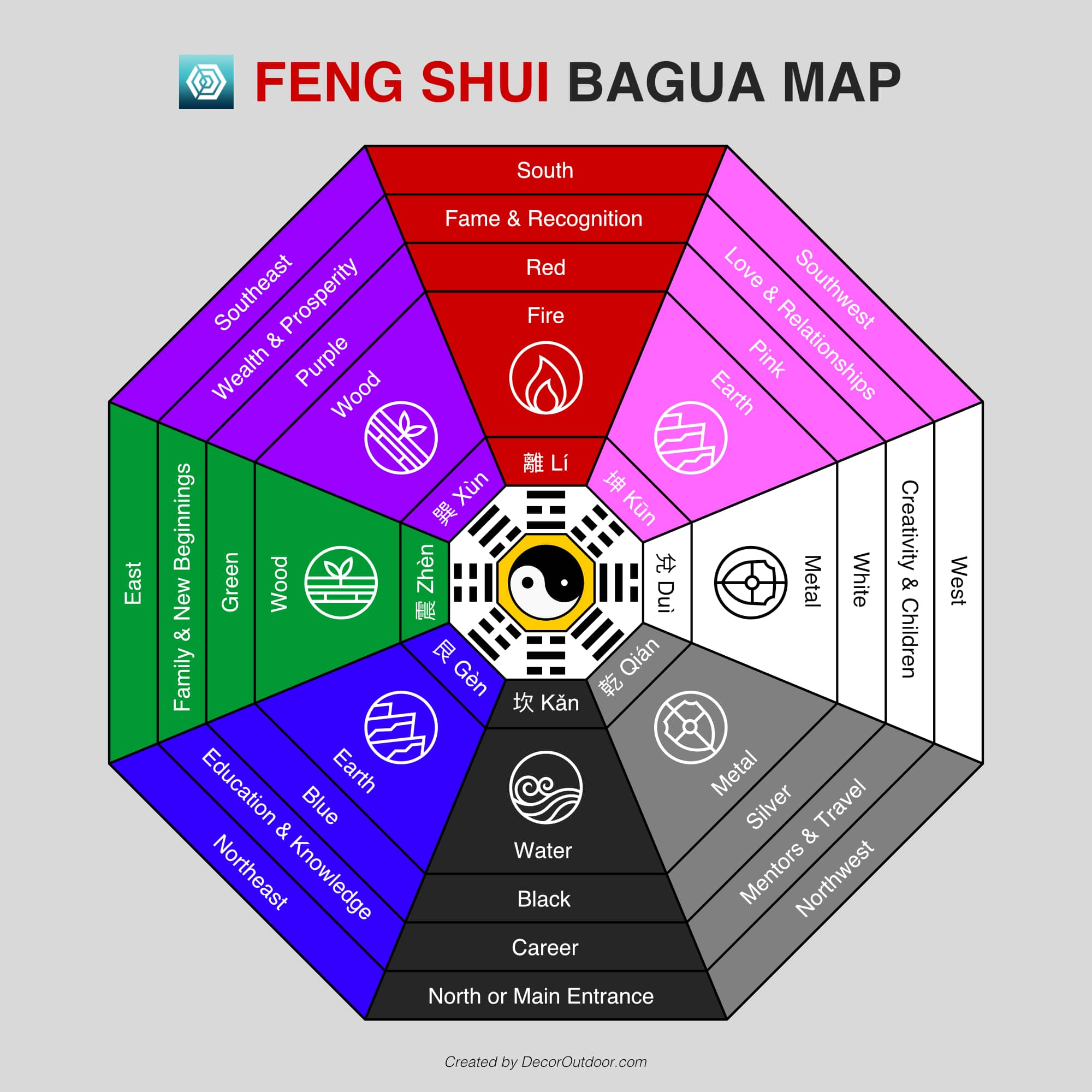
3 Celestial Guardians
The Foo Dog represents one of three divine Chinese creatures sent to Earth to safeguard the cosmic luck trinity of Tien Di Ren (or Tien Ti Ren). They combat the ill effects of the three evils or killings known as Sarm Saat.
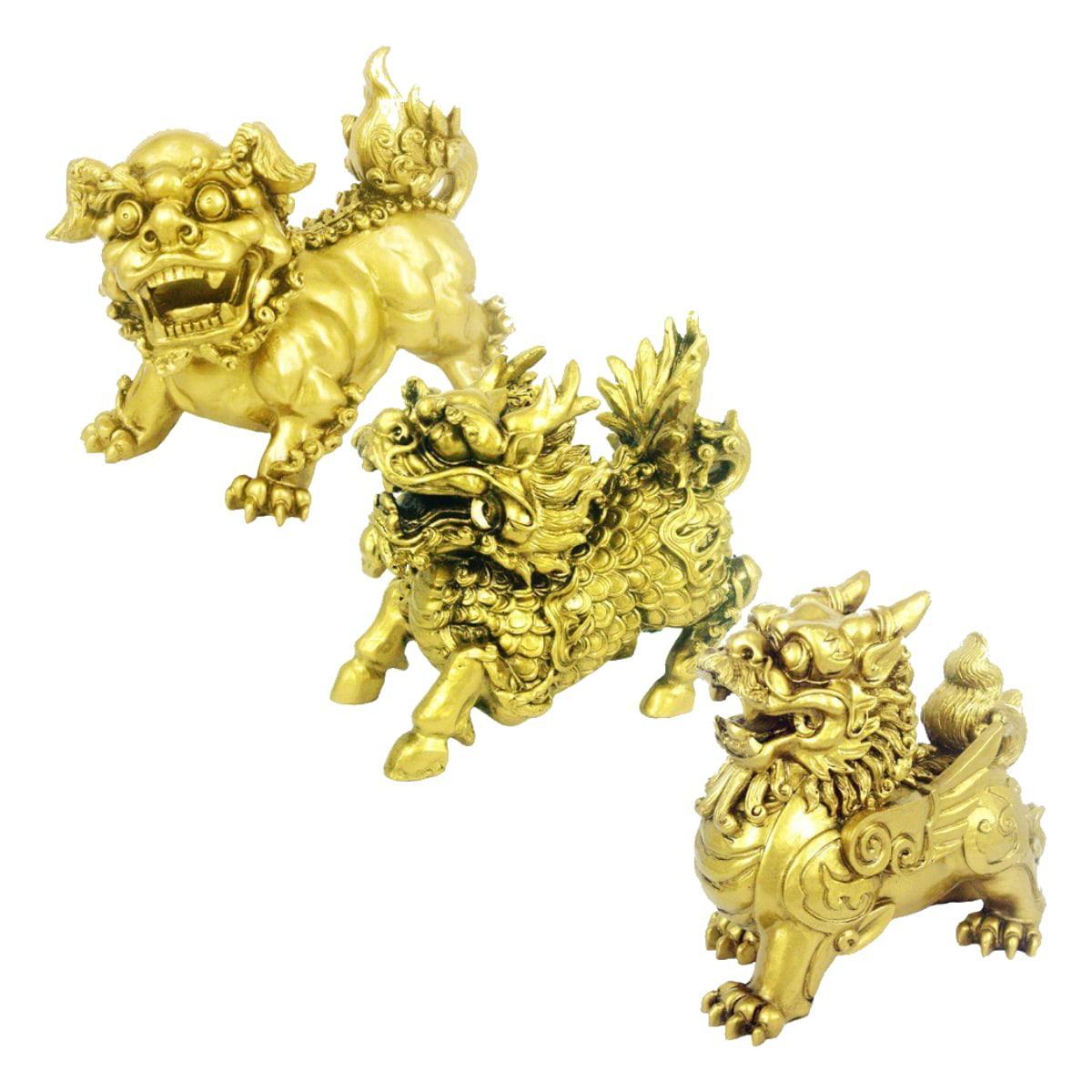
- Foo Dog – As mentioned earlier, this dog/lion has male and female versions (representing yin and yang). They protect the inside and outside of a building or dwelling by warding off evil spirits.
- Chi Lin (Qi Lin or Gi Lin) – This chimera has the body of a horse covered by koi scales with a dragon’s head. Often called a Chinese Unicorn (though they may have one, two or no horns at all), this legendary beast promises success, wealth, wisdom, longevity and protection among other things.
- Pi Xiu (Pi Yao or Pi Xie) – This powerful mystical creature is also a hybrid that varies by geography and time period. Generally, it’s depicted with a lion or dog-like body and a dragon’s head. Sometimes it has a horn or wings. It’s loyal, obedient, protective and brings good fortune while fighting off harm to its owner.
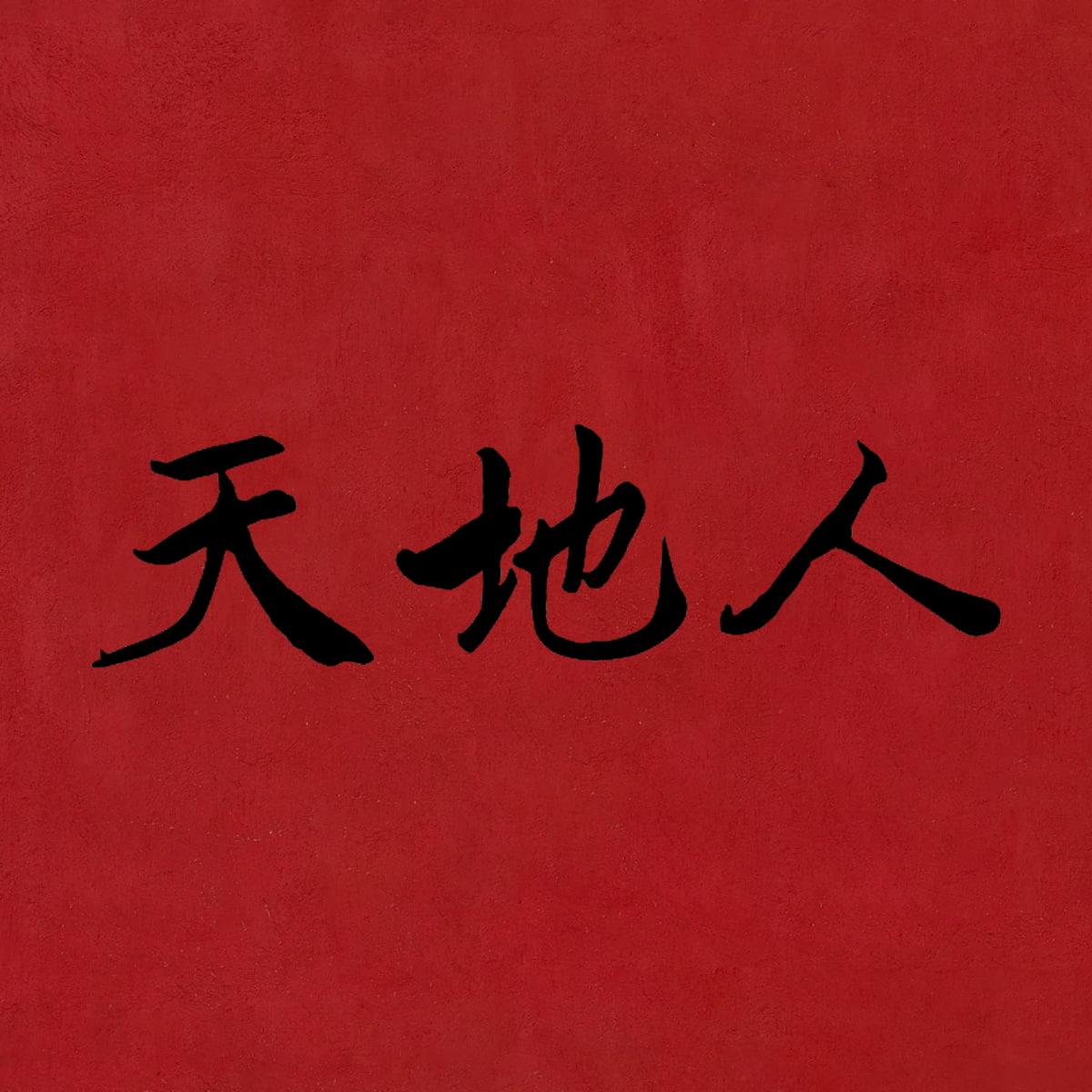
Tien Di Ren
A person’s good fortune in life can depend on three types of luck called Tien Di Ren.
- Tien (Heaven) – This represents the luck from astrological influences such as the time, date and planetary movements when we were born. It’s our destiny and we have no control over it.
- Di (Earth) – Geographical location, environment, orientation and topographical elements at home and work determine this type of luck. Feng Shui can influence the levels of positive and negative energy here.
- Ren (Man) – This is the one form of luck that we control through our behavior, achievements, beliefs and relationships. What we know, our skills, and the support we have all make it better.
The celestial guardians are among the most revered protectors and are ubiquitous in Chinese culture. They’re found prominently in and around temples, homes, offices and government edifices. Pairs of one type will subdue the negative effects of Sarm Saat but utilizing all three eradicates them.
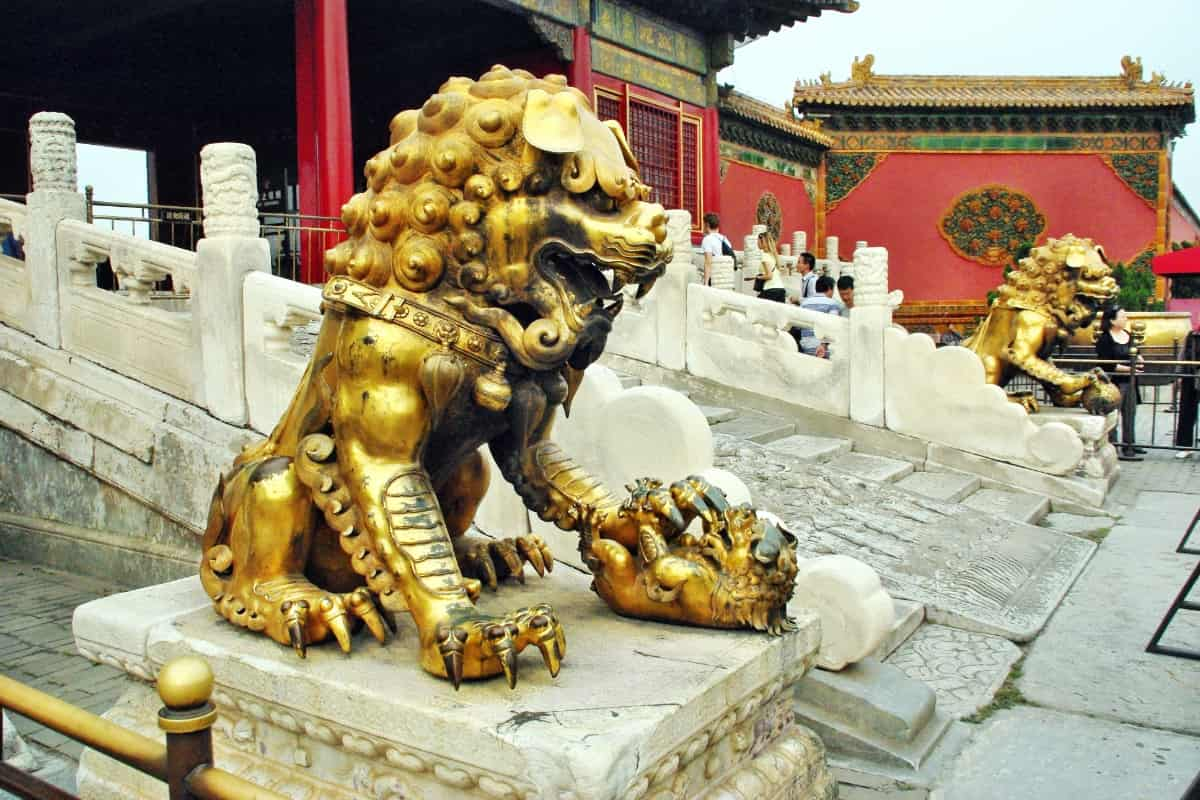
Concluding thoughts
In feng shui, you can go as crazy or casual as you like with how and where you display your shishi. You might have two males, two females or just one altogether, so take everything with a grain of salt. Treat them with respect and feel free to pat them in thanks for keeping you safe. But, be sure to keep them facing outward from the front door, so they keep evil spirits out of, rather than in your home.
The global reach of business has shown that different cultural traditions can help create a welcoming atmosphere. Consequently, energy flow practices and totems like Foo Dogs are becoming more common in the workplace [Ogilvie, Ng, Xiang, Ryan & Yong 2018]. If you think you’re starting to go a little overboard, know that a foo dog tattoo is a popular Asian design. Comparatively speaking, adding a statue or two outside your home is a pretty low commitment.
Frequently Asked Questions – Foo Dogs
Where do you place foo dogs?
The male Fu Dog (the one holding the globe) is always placed on the male, or Dragon side of the house (to the right of the main door). The female Fu Dog (with the cub) is placed on the female, or Tiger side of the house (to the left of the main door).
What rituals are performed when placing foo lions?
Placing Foo Dogs isn’t just decorative—it’s a spiritual tradition that brings protection, peace, and prosperity. This guide outlines an easy-to-follow ritual to respectfully activate and place your statues using traditional feng shui principles.
Preparation (1–2 Days Before)
- Clean the entrance where the statues will be placed.
- Wipe the statues with a soft cloth and purified water (optionally infused with mugwort, pomelo leaves, or sea salt).
- Gather these items:
- 3–9 incense sticks per statue
- Red cloth or ribbon (optional, for decoration)
- Offerings: oranges, apples, tea, rice wine, sweets
- Red paper and cinnabar paste or red ink (for the eye-opening ritual)
- Pick a lucky day and time using a feng shui calendar or Tong Shu.
Ritual Steps
1. Begin the Ceremony
- Face the entrance; place statues nearby but not in final spots.
- Light 3 incense sticks per statue.
- Bow 3 times and recite: ”We welcome the guardians of heaven and earth. Protect this space, bring peace, and attract prosperity.”
2. Activate the Statues (Kai Guang)
- Dip a brush or cotton swab in cinnabar paste or red ink.
- Gently dot the right eye, then the left eye of each statue.
- Say: ”With this mark, I open your eyes. May you see clearly and guard wisely.” (Optional: Add a mantra like “Om Ma Ni Pad Me Hum” or “Zhao Cai Jin Bao.”)
3. Place the Statues
- Set the male (ball) on the right, female (cub) on the left (as seen from inside looking out).
- Face them outward and align them symmetrically.
4. Offer Thanks and Gifts
- Place fruit, tea, and sweets in front of the statues.
- Light incense again if you like.
- Recite: ”Thank you for your presence. May your protection be strong and your blessings abundant.”
5. Ongoing Care
- Clean seasonally, especially before the Lunar New Year.
- Replace offerings on special dates or when needed.
- Avoid placing the statues in dark, messy, or unclean areas.
Why do fu dogs come in pairs?
Foo dogs are meant to be a pair. Foo dogs are symbolic, protective statues, and they are designed in pairs — one is female, the other is male. The female represents yin, and symbolically protects the people dwelling inside the home, while the male statue, representing yang, protects the structure itself.
References
- Ogilvie, M., Ng, D., Xiang, E., Ryan, M. M., & Yong, J. (2018). Using traditional rituals in hospitality to gain value: A study on the impact of Feng Shui. International Journal of Hospitality Management, 72, 1-9.





Hi. I have two Foo dogs, both with globes and open mouths. Both are very, very similar, only one has male attributes and the other does not. Does this mean that one is female and the other is male?
Male foo dogs will have a globe, while females have a cub. Depending on the level of detail that is visible, the item under their paws may look similar. If they are old carvings (versus more modern castings), the cub’s distinguishing features may have worn down so it looks more like a globe.
I have 2 Foo dogs and would like to know the value of them please
Unless there are distinct markings that clearly identify the maker and date, I would suggest checking out collectibles and selling websites (e.g. eBay) to get some idea of what you have or what similar items are selling for. If you can authenticate that they are Asian antiques, then higher-end auction houses might provide more specific price ranges.
I want to buy foo dogs. Can they be placed on a window sill next to my main door? My house is small and I have a wall facing the front door could they be placed there?
Hello I’m looking at getting a foo dog iv seen a mail one with a ball . But there’s no female one is it ok to get a female of a different design or do they have to be matching
Tradition mandates that you have a male/female pair and that they should be arranged facing each other. Otherwise you won’t get the beneficial effects.
Having two of the same sex might be bad juju.
Hi, I have one fu dog and it’s a female. Do they have to be in pairs or can I have two females, if I can’t find the male?
I have a pair of cream and gold ceramic Foo dogs that I purchased about 25 years ago.
I have placed them on a bookshelf that faces the main entrance to my home (South). After reading your article, you point out that there is usually a male and female pair whereby the female will have a cub under her inside paw and the male will have a ball under his paw.
However, my pair appear to be both males. Each one has both front paws placed on top of a ball and they are looking inward (one looking to the right, and the other looking to the left). Before reading your article, I had them position with their body facing forward horizontally with their heads positioned straight toward toward the front entrance door.
Just wondering if having their bodies facing forward with their heads turned inward would render protection and good energy, or should I change them back to their original position? Thank you.
I think your instinct to face them forward and looking inward is probably best. The manufacturer was likely focused on symmetry rather than accuracy when they designed these pieces. Given that they are both males who protect the outside, you may want to incorporate other Feng Shui inside your home for holistic coverage.
I just purchased two fu dogs and having difficulty learning about them, as I can’t translate the stamp on each of them. So far my wife and I believe that they are: shiwan stoneware?, circa 1920’s?, Jun glaze? They are 17 inches tall, both male work Vines and lotus flower, and both Fu dogs have both front feet on a hollow ball. Beautiful works of art just don’t know how to pin down exactly where and when they are from. Any help greatly appreciated.
What about this – 2 identical male Burma lions with nothing under their paws and straight legs. Will the same positions apply?
Thank you.
My sweet 94 yr old neighbor has sold and moved from his house. He gifted me his male foo dog. I’m sorry I don’t know the proper Feng Shui for his placement being solo.
Well, the male is normally placed on the right as you face the door. At least you have protection for the outside of your home.
Love the history, I have a Shishi Fu Foo dog lion standing over what looks like coins under it on the base and a pup over his back with its front two legs standing on a ball. Both have their mouths open and the colour is brown/bronze, its very heavy to. Anything you can tell me about it?
I have a couple of Foo Dogs and am trying to determine their sex. One is a little larger has its mouth closed and curious, perfectly round holes at the corners of the mouth. The other one is a trifle darker in colour (both of them are green) and is roaring (sans holes)…
Male foo dogs typically have a ball under their paw, while females have a cub under theirs.
I know this is not a dream site but my dream has to do with Foo Dogs. I hope I can get some answers.
In my dream, I was in an old wooden cottage. There was an old Asian man sweeping the wood floor with the front door open. It was dark and raining outside. Off to my left, there were three large white foo dogs floating off a wooden shelf. I told the old man did you see that? he giggled and shook his head. I know you are supposed to have two foo dogs but is there an instance where you can have three in your home?
Thank you.
I purchased two foo dogs today for my sister from a thrift store. Both of them have a gold stick looking thing in their mouths and one has a red and gold tassel on it. What does that mean?
The gold sticks are most likely swords. Foo dogs with swords in their mouths are believed to be especially potent in warding off killing or attacking energy – sha chi. This negative low feng shui energy vibe may be generated from nearby hospitals, graveyards or protruding objects and sharp corners within the home. These sword-bearing guardians can also help cast away evil spirits, black magic and prevent accidents.
I have a double headed Feng Shui Foo Fu dog (Lion) sconce light fixture. It is made of either brass or bronze. It has electric candelabra bulb fixtures on top of the heads. No feet. I am trying to learn about its history and era. The wiring suggests that is at least vintage and possibly antique. There are two Fu dog heads with a circular center piece that to which they are attached. Each head is about 3 – 3.5 inches in height. Any info would be appreciated.
Sherry –
Any photos? I would certainly check the bottom and back for any identification marks or branding.
These comments are very much appreciated. Many years ago I purchased two large Friendly Foo Dogs in Los Angeles CA and after 30+ years, am certain they are very valuable. How to determine their value today? Thank you.
Are they lamps or statuettes? What are they made of? Is there any branding that might help identify them?
I received my foo dogs statues today and I am so happy I love them.
I have a pair on my bookshelf, I’ve always been fond of them but I never knew their history. Very good read.
I just bought a foo dog door knocker. I don’t know how to tell if it is male or female?
Stella, if the object under the paw is a ball, then it is male. If it is a lion cub, then it is female. If neither, then I guess it’s asexual.
Female will have a cub under her foot
Feng Shui is very important. Glad to learn more about Foo Dogs!
Very interesting article. Very informative.
Well you blew my mind on this one. What inspired you to learn all this stuff? What inspired you to make it part of your business?
Seems sort of random, huh? The truth is that one of our best selling products over the years has been a set of Foo Dogs table lamps from Barbara Cosgrove. I was in Taipei City a few years ago and noticed similar statues all over the place. I became curious about the origin, implications and protocols, so I decided to do a little research. Glad you enjoyed the article.
Brilliant! I have two foo dogs and never knew exactly where to place them. Or that there was a tradition to placing them. Thanks. Quick question… Can I take them in my car? I always like putting them on the dashboard. Is that cool? Or does that break any feng shui rules?
Well, that’s certainly something that I never thought of. I couldn’t find any specific mention of Foo Dogs use inside of automobiles, but I would imagine that evil energy would enter through the front windshield (unless you’re backing up, in which case you’re kind of screwed). So, I would recommend that you place them on the dashboard facing out toward the front of the car, with the male on the right and female on the left as you face in (just as if they were outside of a doorway). I know that this arrangement leaves you staring at Foo Dogs’ butts while driving, but better that than bad Feng Shui on the road.
I was recently in China and saw Foo Dogs everywhere, from private homes to businesses to the great wall.
But I didn’t know where they came from or the various details of color and placement. Thank you!
Daniel, you can really go down the rabbit hole when it comes to feng shui and Foo Dogs. Each culture has its own unique take on the mythology and adds meaning to nuanced elements in their designs.
OMG. Always wondered.
The origin and history of Foo Dogs is fascinating. Once you get into the bagua map considerations, you can really go down the feng shui rabbit hole in a hurry.